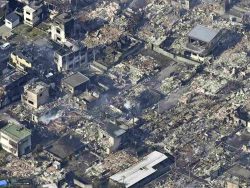
After the Kumamoto Earthquake, many people are seen staying overnight in their cars in this file photo taken in April 2016 in Mashiki, Kumamoto Prefecture.
18:25 JST, April 15, 2021
Local governments are taking different approaches toward whether evacuees should spend nights in cars at times of natural disasters.
According to a recent Yomiuri Shimbun survey on the matter, some governments are flexible with their measures, in line with citizens’ needs and circumstances, while others remain cautious. Since they are urged to take different actions depending on the type of disaster, local governments are asking the central government to draw up guidelines to avoid causing confusion among evacuees.
Some are supportive
“Concern over coronavirus infections at evacuation centers has prompted some to prefer to stay overnights in cars. We have no choice but accommodate such wishes now,” a Yamaguchi city government official said.
Out of concern over so-called economy class syndrome, the city had previously recommended citizens not to shelter in cars. But in June last year, it added to its disaster manual a support measure for evacuees who chose to do so. It decided to draw up the measure for the first time to cope with a possible increase in the number of such evacuees who fear becoming infected at evacuation centers.
It decided that flyers and health check sheets, as well as food and water, would be provided at evacuation centers’ parking lots to those who wish to stay overnight in cars. During the approach of powerful Typhoon No. 10 in September 2020, about 800 people in Yamaguchi City evacuated to a community center, and one family said they preferred to spend the night in a car. The municipality accommodated the family’s wishes in line with the revised manual.
“We realized the necessity of the manual because we might not have been able to grasp the situation of those who spend nights in cars otherwise,” an official said.
The Fukushima city government, too busy with virus control to set up new evacuation centers, decided last summer to strengthen ties with supermarkets and increased the number of store parking lots that can be used for evacuees to stay in their cars.
The Hiroshima prefectural government began distributing compression stockings to its municipalities in April last year for their potential effect of preventing economy class syndrome. It will also announce a list of evacuation centers with information on whether they have parking lots.
“We hadn’t recommended that our citizens take shelter in cars, but we must think again and find ways to utilize cars,” a prefectural government official said.
Others are wary
The Yomiuri Shimbun survey showed 39 prefectural and city governments answered that they either did not take measures for evacuees sheltering in cars or were now only considering such measures.
Yokosuka, Kanagawa Prefecture, has an infection control manual for use after earthquakes that calls sheltering in a car “impossible” on the grounds of health risk, possible accidents around evacuation centers and potential blockage of the transport of relief supplies.
“We can cope with the risk of infection by expanding shelter space,” an official said.
Sendai, hard-hit by the Great East Japan Earthquake, is not recommending that people stay overnight in their cars because citizens are advised to evacuate on foot out of concern over tsunami and causing traffic jams.
However, the city government will discuss with supermarkets whether their parking lots can be used for evacuees to stay in cars, after receiving inquiries asking if it is possible to evacuate in a car.
“If we become proactive about it, residents might think it is OK to use a car to evacuate,” an official said. “It is difficult to state flatly across the board what to do in a time of disaster, because what one must do will vary depending on one’s location and living environment.”
State urged to decide
The Cabinet Office said spending nights in a car “cannot be actively recommend, given the risks.”
On the other hand, it issued a notice to municipalities in July last year on virus control at evacuation centers that included steps to enable evacuees in cars to receive relief supplies and health counseling.
A Shizuoka prefectural government official said: “I think staying in a car is effective for predictable storms and floods, but for tsunami, evacuation on foot is the principle. We worry about whether we can widely disseminate measures that differ depending on the type of disasters.”
The local government asked the central government to draw up guidelines for evacuation in cars.
The Shimane prefectural government said, “We’d like the central government to draw up guidelines that specify ideal places and means for evacuation in a car, along with past examples.”
University of Hyogo Prof. Yoshiteru Murosaki, who specializes in disaster prevention planning, said: “As long as evacuees [in cars] can receive the same support as those at evacuation centers, such as meals, toilets and baths, staying in a car can be an effective means of evacuation. However, it can be dangerous in case of tsunami or river flooding.
“Municipalities need to present residents with measures in a comprehensible way, such as by compiling a guidebook to prevent confusion.”
"Society" POPULAR ARTICLE
-

M7.5 Earthquake Hits Northern Japan; Tsunami Waves Observed in Hokkaido, Aomori and Iwate Prefectures
-

M4.9 Earthquake Hits Tokyo, Neighboring Prefectures
-

Fire Damages 170 Buildings in Oita, Western Japan
-

M5.7 Earthquake Hits Japan’s Kumamoto Pref., Measuring Upper 5 Intensity, No Tsunami Expected
-

Beloved Cat Stationmaster Nitama in Wakayama Pref. Passes Away at 15
JN ACCESS RANKING
-

Japan’s Hopes for Seafood Exports Shot Down in China Spat
-

Essential Services Shortage to Hit Japan’s GDP By Up to ¥76 Tril. By 2040
-

Japan to Charge Foreigners More for Residence Permits, Looking to Align with Western Countries
-

Japan Exports Rise in October as Slump in U.S. Sales Eases
-

Japan GDP Down Annualized 1.8% in July-Sept.

















